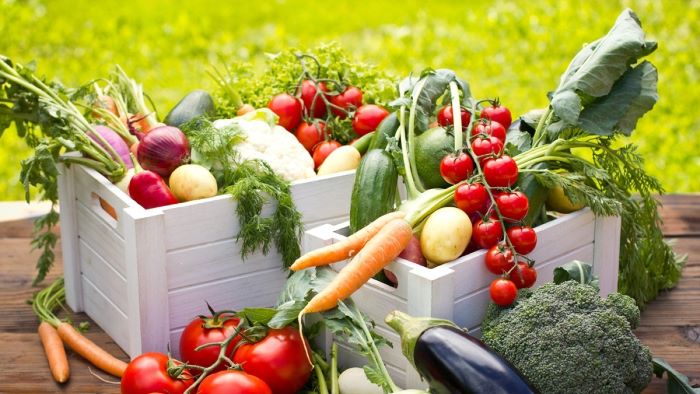Are you looking for a way to eat healthier, save money, and have fun at the same time? If so, you might want to know the list of easy vegetables to grow at home. You don’t need a large garden or a lot of experience to grow your own food. In fact, you can start with just a few pots and some seeds.
To help you out, we have jotted down 9 easy vegetables you can grow in your home garden. These vegetables are low-maintenance, fast-growing, and delicious.
So, let’s get started! Here are 9 easy vegetables to grow in your home garden.
Contents
9 Easiest Vegetables to Grow at Home Garden!
Growing your own vegetables can be a rewarding and healthy hobby. However, not all vegetables are easy to grow, especially for beginners. Some may require more space, time, or care than others. If you are looking for some easy vegetables to grow at home, here are a few options that you can try.
1. Lettuce
Lettuce is one of the easiest and fastest vegetables to grow at home. You can simply sow the seeds directly in the soil or in containers, and harvest the leaves in as little as four weeks. Lettuce prefers cool weather, so you can plant it in early spring or fall. Furthermore, you can also grow it indoors near a sunny window.

Additionally, lettuce has many varieties, such as romaine, butterhead, leaf, and iceberg. Plus, it is recommended to pick the leaves as needed or cut the whole head when it is mature.
2. Radishes
Radishes are root vegetables that have a crunchy and peppery taste. They can grow best in cool weather, so you can plant them in spring or fall. You can also plant them between other crops, such as lettuce or carrots, to save space and deter pests. In addition, they come in different shapes, sizes, and colors, such as red, white, purple, and black.
3. Green Beans
Green beans are also known as snap beans or string beans. They are pod vegetables that have edible seeds inside. You can sow the seeds directly in the soil after the last frost date, and harvest them in about 50 to 60 days.
Furthermore, green beans grow best in warm weather, so you can plant them in summer. Plus, you can choose between bush beans or pole beans, depending on how much space you have.

For instance, bush beans are compact and do not need support, while pole beans are vining and need a trellis or stake to climb on.
4. Peas, One of the Easy Vegetables to Grow at Home Garden
Peas are legumes that have sweet and tender pods that contain edible seeds. The seeds can be sown directly in the soil and harvested in about 60 to 70 days. Additionally, peas grow best in cool weather, so you can plant them in early spring or late summer.
Plus, you can choose between shelling peas or snap peas, depending on whether you want to eat the pods or not. Shelling peas have tough pods that need to be removed before eating, while snap peas have edible pods that can be eaten whole.
5. Carrots
Carrots are root vegetables that have a crunchy and sweet taste. They grow best in loose and sandy soil that is free of rocks and weeds. Plus, you can also grow them in containers or raised beds if your soil is heavy or clayey.

Furthermore, carrots can be planted from seeds or seedlings. Seeds should be sown 1/4 inch deep and two to three inches apart in rows that are one foot apart. Seedlings should be transplanted carefully to avoid damaging the roots.
Additionally, carrots do not like to be disturbed once they are established, so thinning should be done by snipping or pinching off the excess plants at the soil line.
6. Cucumbers
Cucumbers are annual vegetables, which means they complete their life cycle in one year. They belong to the same family as melons, squash, and pumpkins. Plus, cucumbers are of two types: vining and bush. Vining cucumbers produce long vines that can be trained to grow on a trellis or fence. On the other hand, bush cucumbers produce shorter vines that can be grown in containers or small spaces.
HGIC stated: “Begin harvesting when cucumbers are about 2 inches long up to any size, but before their flesh becomes bitter, seeds harden or skins begin to yellow. Pickling types should be harvested between 2 and 6 inches in length, while slicing and burpless types are typically picked between 6 and 10 inches long.”
Moreover, cucumbers need full sun or partial shade, loose and well-drained soil, and regular watering to grow well. The soil should have a neutral to slightly alkaline pH of around 7.0. Adding compost or manure can improve the soil fertility and texture.
7. Swiss Chard
Swiss chard is a leafy green vegetable that belongs to the same family as beets and spinach. It has colorful stems and veins that contrast with its dark green leaves. It is rich in vitamins, minerals, antioxidants, and fiber. Plus, it can be eaten raw in salads, cooked in soups, stews, stir-fries, or baked dishes.

Furthermore, growing Swiss chard is easy and rewarding. As, you can start seeds indoors or sow them directly in the garden after the last frost. They prefer a sunny location with well-drained soil that is rich in organic matter, and it can tolerate partial shade and light frost.
Swiss chard will regrow if you leave some leaves on the plant.
8. Kale, Easy Vegetable to Grow at Home
Kale is a popular and nutritious leafy green vegetable that belongs to the cabbage family. It has curly or flat leaves that range from green to purple in color. They are high in vitamin A, C, K, iron, calcium, and antioxidants.
Additionally, kale likes a cool and moist environment, so you can plant it in spring or fall. It can withstand frost and even improve its flavor after a cold snap. You can harvest the outer leaves as they mature or cut the whole plant at the stem.
9. Summer Squash
Summer squash is a term that covers a wide range of tender fruits that grow in different shapes and colors. Some common types of summer squash are zucchini, yellow squash, patty pan squash, and ball types. Summer squash is low in calories and high in vitamin C, potassium, and fiber. It can be eaten raw or cooked in salads, stir-fries, soups, breads, or desserts.
You can sow the seeds directly in the soil after the last frost date, and harvest them in about 50 to 60 days.
FAQs
What vegetables are easy to digest?
Some vegetables that are easy to digest are cucumbers, lettuce, zucchini, carrots, spinach, and green beans. These vegetables are low in fiber and high in water content, which makes them gentle on the stomach and intestines. They also contain enzymes that help break down food and nutrients.
What vegetables can grow in 3 weeks?
Some vegetables that can grow in three weeks are radishes, lettuce, spinach, arugula, kale, and Swiss chard. These vegetables are fast-growing and have short maturity times, which makes them ideal for quick harvesting.
Conclusion
Hopefully, you enjoyed reading this blog: easy vegetables to grow at home. Growing your own vegetables at home is a rewarding and enjoyable hobby that anyone can do. You don’t need a lot of space, time, or money to start your own mini-farm. All you require are some pots, soil, seeds, water, and sunlight. And of course, some enthusiasm, and curiosity.
By growing your own vegetables, you will be able to eat fresh, organic, and tasty produce that you can be proud of. You will also save money, reduce waste, and improve your health and happiness.
So, what are you waiting for? Pick one or more of the 9 easy vegetables that I have suggested and start planting today. You will be surprised by how much fun and satisfaction you will get from growing your own food.
Happy gardening! 😊

Hi, I’m Jacqueline, the editor-in-chief of cozynest. I have a passion for plants and gardening, also, have a degree in horticulture from the University of California, Davis. I love to share my knowledge and experience with our readers and help them create beautiful and healthy gardens, indoors, and outdoors. I also enjoy experimenting with different plant varieties, designs, and techniques, and learning from other experts in the field. When I’m not working on cozynest, you can find me in my own cozy nest, surrounded by my favorite plants and books.

